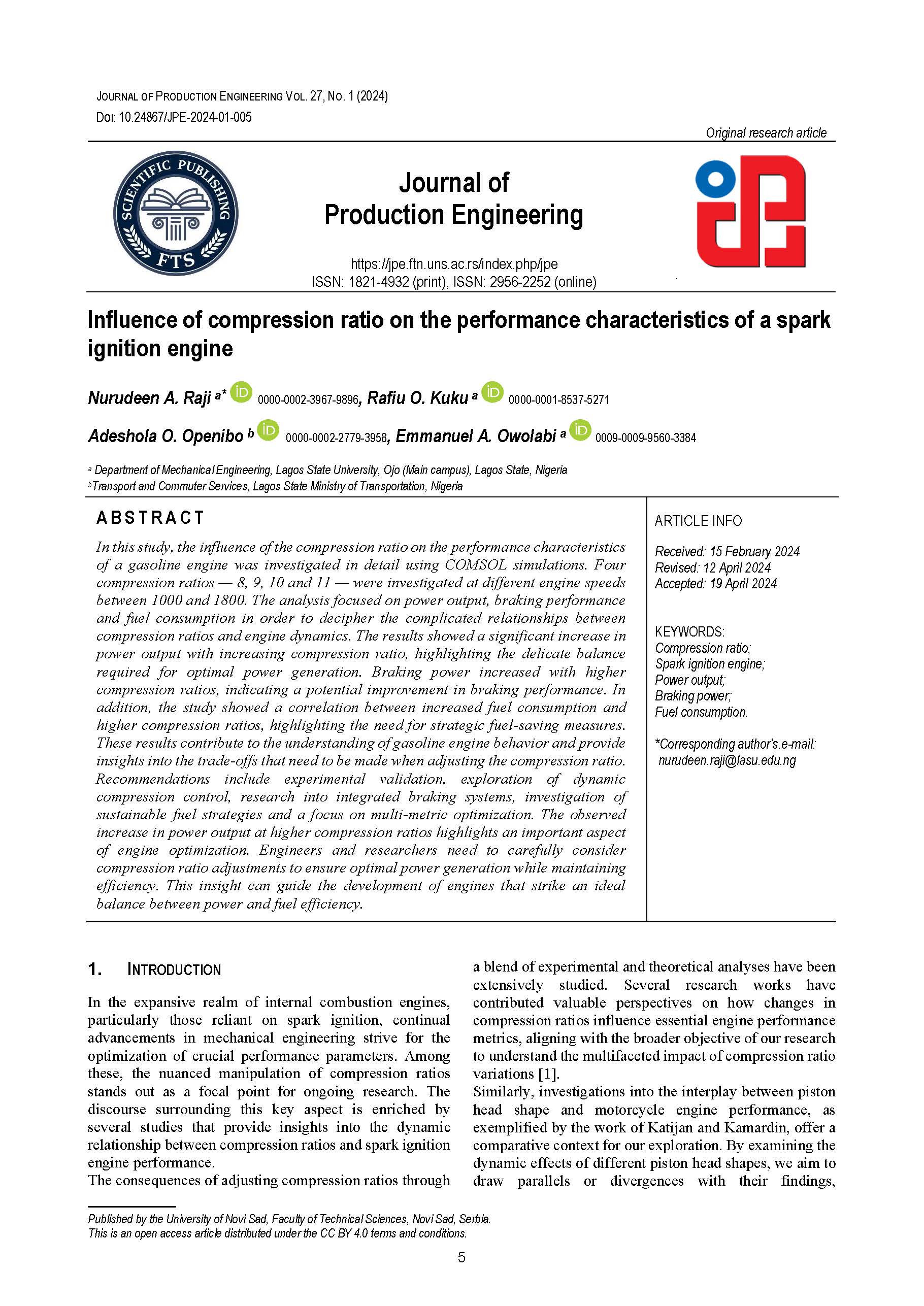Influence of compression ratio on the performance characteristics of a spark ignition engine

Published 2024-06-23
abstract views: 279 // FULL TEXT ARTICLE (PDF): 0
Keywords
- Compression ratio,
- Spark ignition engine,
- Power output,
- Braking power,
- Fuel consumption
How to Cite
Copyright (c) 2024 Journal of Production Engineering

This work is licensed under a Creative Commons Attribution 4.0 International License.
Abstract
In this study, the influence of the compression ratio on the performance characteristics of a gasoline engine was investigated in detail using COMSOL simulations. Four compression ratios — 8, 9, 10 and 11 — were investigated at different engine speeds between 1000 and 1800. The analysis focused on power output, braking performance and fuel consumption in order to decipher the complicated relationships between compression ratios and engine dynamics. The results showed a significant increase in power output with increasing compression ratio, highlighting the delicate balance required for optimal power generation. Braking power increased with higher compression ratios, indicating a potential improvement in braking performance. In addition, the study showed a correlation between increased fuel consumption and higher compression ratios, highlighting the need for strategic fuel-saving measures. These results contribute to the understanding of gasoline engine behavior and provide insights into the trade-offs that need to be made when adjusting the compression ratio. Recommendations include experimental validation, exploration of dynamic compression control, research into integrated braking systems, investigation of sustainable fuel strategies and a focus on multi-metric optimization. The observed increase in power output at higher compression ratios highlights an important aspect of engine optimization. Engineers and researchers need to carefully consider compression ratio adjustments to ensure optimal power generation while maintaining efficiency. This insight can guide the development of engines that strike an ideal balance between power and fuel efficiency.
Dimensions Citation Metrics
References
- Aina, T., Folayan, C., Pam, G. (2012). Influence of compression ratio on the performance characteristics of a spark ignition. Advances in Applied Science Research, vol. 3, no. 2, 1915-1922.
- Katijan, A., Kamardin, A. (2019). The effect of compression ratio by different piston head shape on the performance of motorcycle engine. International Journal of Automotive and Mechanical Engineering, vol. 16, no. 3, 6906-6917, DOI: 10.15282/ijame.16.3.2019.06.0518.
- Mohammed, K. (2016). The effect of compression ratio upon the performance and emission of spark ignition engine. International Journal of Engineering and Technical Research, vol. 5, no. 3, 2454-4698.
- Nguyen, X., Ocktaeck, L. (2022). Influence of combustion duration on the performance and emission characteristics of a spark-ignition engine fueled with pure methanol and ethanol. ACS Omega, vol. 7, no. 17, 14505-14515.
- Saheed, W., Rashid, A., Afiq, D. (2018). Combustion characteristics of spark ignition engine fuelled by compressed natural gas in a direct injection compressed natural gas engine. International Journal of Applied Engineering Research, vol. 13, no. 1, 727-731.
- Bulatović, S., Aleksić, V., Zečević, B., Prohaska, B. (2023). Presence of crack due the constant exploitation of turbine shaft. Advanced Technologies and Materials, vol. 48, no. 1, 21-25, DOI: 10.24867/ATM-2023-1-004.
- Knežev, M., Živkovic, A., Marinković, D., Mladjenović, C., Andrei, C., Ilić, V. (2023). Modal analysis of motorized spindle using finite element method. Journal of Production Engineering, vol. 26, no. 1, 9-12, DOI: 10.24867/JPE-2023-01-009.
- Kosec, B., Karpe, B., Gojić, M., Tanasić, Z., Kosec, G., Antić, A., Nagode, A. (2023). Inductive heating and quenching of planetary shafts for diesel engine starters. Advanced Technologies and Materials, vol. 48, no. 2, 55-60, DOI: 10.24867/ATM-2023-2-003.
- Bodzás, S. (2023). Geometric analysis and design of flat form tools. Journal of Production Engineering, vol. 26, no. 1, 1-8, DOI: 10.24867/JPE-2023-01-001.
- Krishna, S., Saravana, R. (2020). The study of impact of compression ratio on the performance and emission characteristics of DTSI engine using petrol and CNG as fuel. Journal of Archaelogy of Egypt/Egyptology, vol. 17, no. 9.
- Snehashis, P., Finšgar, M., Gotlih, J., Brajlih, T., Banerjee, P., Yapar, Ö., Lojen, G., Bončina, T., Drstvenšek, I. (2023). Analyzing properties of semi-molten powder granules in laser powder bed fusion. Journal of Production Engineering, vol. 23, no 2, 23-29, DOI: 10.24867/JPE-2023-02-023.


